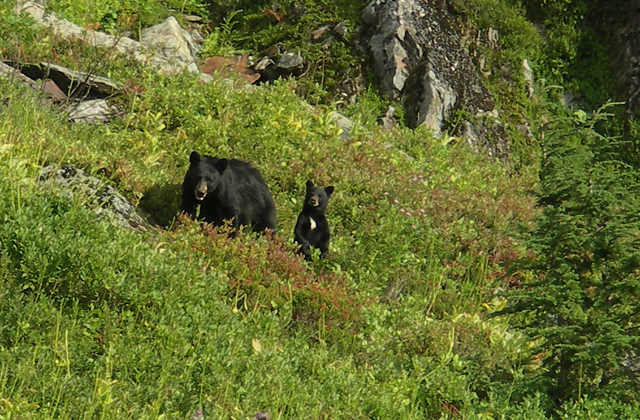In Spring, More Wildlife -- Including Bears and Ticks -- Out and About
Spring is a sensitive time for wildlife, and a good time to give all animals an extra space and respect. Test your trail smarts about hiking in habitats that bears or ticks call home.
Larger mammals, like bears, tend to get all the attention when they make their first appearances in spring, but this season is an active time for many wildlife, from birds to bees to, yes, ticks.
Spring is a sensitive time for wildlife, and a good time to give all animals an extra space and respect. Test your trail smarts about hiking in habitats that bears or ticks call home.
How to hike in bear country

Many parts of Washington are black bear country, and at lower elevations and along the coast, this is about the time when they start to come out of hibernation.
"Black bears usually start making appearances in mid-to-late April, but warm weather can cause them to stir earlier," says Rich Beausoleil, bear and cougar specialist for the Washington Department of Fish and Wildlife (WDFW). The spring diet for black bears consists mostly of herbaceous plants, from emerging grasses and sedges to horsetail and various flowering plants.
Seeing a bear while hiking is a rare, incredible thrill. Most bears are very shy of humans, but there are some key things to know about bears when you hike, camp, or live in bear country.
- Respect bears and avoid any conflicts by giving them a wide berth, staying calm and not feeding them. Learn more about how to hike and live in bear country.
How to hike in tick country

If you hike in Washington, you're far more likely to run into a tick than you are a bear. This week, trip reporters started reporting ticks in the Blue Mountains and Central Washington.
That's no reason to avoid these excellent spring hiking destinations. With a bit of awareness, the right clothes, preparation and vigilance, hiking in Washington's tick country can be incredibly rewarding and enjoyable.
- Prevention is the key to avoiding ticks for people and pets. Learn more about how to hike and live in tick country.
Respecting (and not feeding) all animals
Respecting all wildlife is one of the Leave No Trace principles. When you hike, it's a good idea to remember you are a visitor in someone else's living room.
Below are the Leave No Trace guidelines to follow for all animals, from the more common stellar jays and chipmunks to the rarer mountain goats or sea otters.
- Observe wildlife from a distance. Do not follow or approach them.
- Never feed animals. Feeding wildlife damages their health, alters natural behaviors, and exposes them to predators and other dangers.
- Protect wildlife and your food by storing rations and trash securely.
- Control pets at all times, or leave them at home.
- Avoid wildlife during sensitive times: mating, nesting, raising young, or winter.
If you love to take wildlife photography, here are some extra tips for responsibly photographing wildlife.
File a trip report
Filing a trip report is a great way to let other hikers know about your wild encounters (especially those pesky ticks) and demonstrate your trail smarts and good trail ambassadorship.


Comments
Bears
I've seen bears in September during berry season, mainly in Mount Rainier National Park where they're protected from hunting. Usually bears will get out of the way if they hear people, but if you're walking near running water or around a blind corner (especially with berries on the trail), you're more likely to cross paths one (as I have). The best thing to do is make a lot of noise when walking in an area with low visibility (talking/singing loud or hand clapping). Bear bells are pretty useless. They make you feel secure but the sound doesn't carry and is easily drowned out by other sounds. I never hear bells on the trail until I'm next to the person wearing them. Save your money and just be loud when you need to.
Posted by:
MapleLeaf on Mar 28, 2016 04:03 PM
Thanks, MapleLeaf
Thanks for sharing. Your comments about speaking up around bends and water echo the advice in our How to Hike in Bear Country article:
http://www.wta.org/hiking-info/basics/how-to/hike-backpack-bear-country
Posted by:
Loren Drummond on Mar 28, 2016 04:09 PM